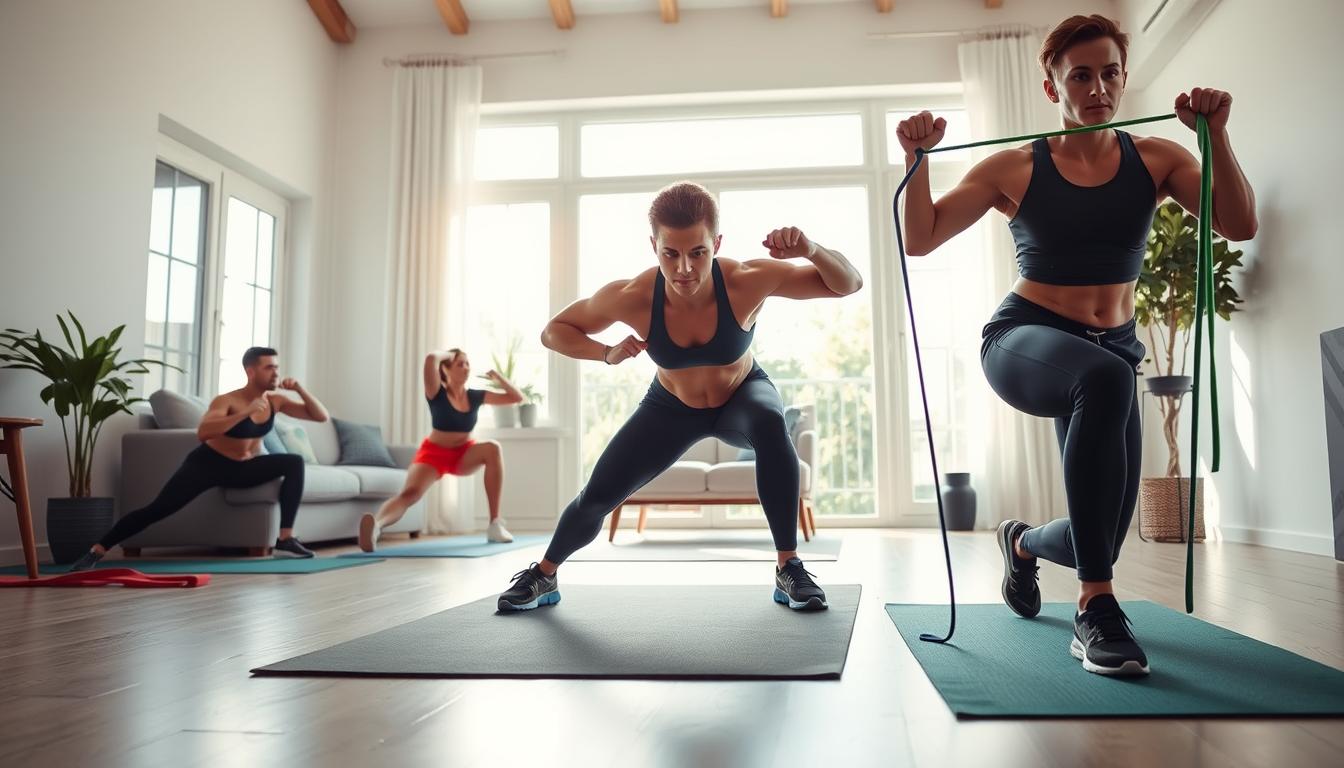Are you fed up with workout plans that don’t match your life or goals? 2025 is looking like a big year for fitness that fits you. Thanks to fitness technology, getting a workout plan that’s just right for you is easier than ever.
Fitness apps have changed the game. They let you have a workout routine that changes with you. But, can these apps really help you create a complete workout routine?
Yes, they can. Modern fitness apps offer personalized coaching and track your progress. They even adjust your workout routine to fit your needs and goals.
Key Takeaways
- Discover the potential of fitness apps in creating a personalized workout routine.
- Learn about the advanced features of fitness apps in 2025.
- Understand how to tailor your workout routine to your specific needs and goals.
- Explore the benefits of using fitness apps for your workout routine.
- Find out how to maximize your results with personalized fitness apps.
The Evolution of Fitness Apps in 2025
In 2025, fitness apps have changed a lot. AI and wearable tech are key. Now, these apps do more than just track workouts. They help with health and wellness in many ways.

Key Technological Advancements
Technological advancements have driven big changes in fitness apps. Artificial intelligence (AI) and machine learning (ML) help apps give personalized advice. They also track user data more accurately.
How AI Has Transformed Workout Planning
AI has changed how we plan workouts. It offers customized fitness plans based on what you want and how you’re doing. AI looks at your data to suggest the best workouts, keeping them challenging but safe.
Integration with Wearable Technology
Fitness apps now work better with wearable technology. This lets users track their workouts and health easily. Wearables send data to apps, helping adjust plans and motivate users.
Assessing Your Fitness Needs and Goals
Starting your fitness journey means first understanding your needs and setting goals. This step is key to making a workout plan that fits you. It keeps you motivated and lets you see how far you’ve come.
Conducting a Self-Assessment
First, you must check where you stand in terms of fitness. Know your good points, areas for improvement, and any physical limits.
Using Assessment Apps for Baseline Measurements
Use fitness apps to measure your starting point. They check body fat percentage, cardiovascular endurance, and flexibility. This info helps craft a workout plan just for you.
Identifying Limitations and Strengths
Spot where you need to get better and what you’re good at. This balance helps set doable goals and keeps you going on your fitness path.
Setting SMART Fitness Goals
Setting Specific, Measurable, Achievable, Relevant, and Time-bound (SMART) goals is crucial. For example, instead of “I want to be healthier,” aim for “I will cut my body fat by 5% in 3 months by exercising for 30 minutes, 3 times a week.”
Here are some SMART goal examples:
- Run a 5K in under 30 minutes in the next 12 weeks.
- Boost your squat by 10 pounds in 8 weeks.
- Keep daily sugar intake under 20 grams in the next 6 weeks.
Identifying Your Workout Preferences
Knowing what you like in a workout is important. Think about the exercises you enjoy, whether you prefer group classes or solo sessions, and the best time for you to work out.

How to Build Complete Workout Routine Using Just Apps in 2025
In 2025, you can use many apps to make a workout plan that fits you. A good plan has strength training, cardio, and flexibility and recovery. These parts help you stay fit and healthy.
The Components of a Well-Rounded Routine
A balanced workout routine is key for fitness and health. It has three main parts: strength training, cardio, and flexibility and recovery.
Strength Training Elements
Strength training helps build muscle and boost strength. Apps offer strength training with weights, bands, or bodyweight exercises.
Cardiovascular Components
Cardiovascular exercises like running, cycling, or swimming boost heart health and endurance. Many apps have cardio workouts for home or outdoors.
Flexibility and Recovery Aspects
Flexibility and recovery are crucial for injury prevention and better flexibility. Apps with yoga, stretching, and mobility exercises are very helpful.
Selecting Apps for Different Fitness Components
Choosing the right fitness apps is important. For strength training, look for apps with weightlifting programs. For cardio, apps that track routes are great.
| Fitness Component | App Examples | Features |
|---|---|---|
| Strength Training | Nike Training Club, JEFIT | Weightlifting programs, exercise database |
| Cardiovascular | Strava, Nike Run Club | Route tracking, pace analysis |
| Flexibility & Recovery | Down Dog, Yoga Studio | Yoga classes, stretching routines |
Creating a Balanced Weekly Schedule
To balance your week, set days for each type of exercise. For example, do strength training on Mondays, Wednesdays, and Fridays. Cardio days are Tuesdays and Thursdays. Use Saturdays for flexibility and recovery.
By mixing these elements and using the right apps, you can make a well-rounded workout routine. This routine will help you reach your fitness goals and stay motivated.
Top Fitness Apps for Strength Training in 2025
In 2025, fitness apps have changed how we train. They help us make our own workout plans, track our progress, and reach our fitness goals. This makes fitness easier and more personal.
Comprehensive Strength Training Platforms
These platforms offer many exercises, plans, and tracking tools. They suit all fitness levels and goals. They aim to improve strength training in a complete way.
FitBod and Strong App Advancements
FitBod and Strong App are leaders in strength training apps. FitBod has a huge exercise library and plans tailored to you. Strong App logs your workouts and tracks your progress. Both have improved in 2025 with better AI and design.
Nike Training Club’s AI Features
Nike Training Club has also grown in 2025. It uses AI to suggest workouts based on your fitness and goals. It also offers real-time guidance and video tutorials for correct exercise performance.
Specialized Apps for Bodyweight Training
For bodyweight fans, there are apps with many routines and plans. These are great for home workouts or those who don’t like equipment.
These apps have bodyweight training programs to boost strength, flexibility, and endurance. They offer customizable plans and progress tracking features.
Apps with AI Form Correction
AI form correction is a big step in fitness apps. These apps use AI technology to check your form and give real-time feedback. This helps avoid injuries and ensures you do exercises right.
Cardio and Endurance Training Apps
In 2025, cardio and endurance training apps have changed the game. They make tracking and improving your health and endurance easy. Whether you’re an athlete or just starting, there’s an app for you.
Running and Cycling Apps with Advanced Features
Running and cycling apps have gotten a lot better. They offer features once only for pros. Strava and Zwift are two great examples.
Strava’s Enhanced Training Analysis
Strava gives you detailed stats like pace and heart rate. It also lets you compete with friends and join challenges. This makes working out more fun.
Zwift’s Virtual Training Environments
Zwift lets you cycle and run in virtual places from home. It makes workouts feel like adventures. This keeps you excited and motivated.
HIIT and Interval Training Applications
HIIT is popular for being fast and effective. HIIT apps offer workouts you can customize. They help you push your limits and see results fast.
Some top HIIT apps include:
- Nike Training Club
- 7 Minute Workout
- HIIT & Cardio Workout by Fitify
Virtual Group Fitness Experiences
Virtual group fitness classes are big in cardio and endurance training. Apps like Peloton Digital and iFIT offer live and on-demand classes. They give you the group motivation from anywhere.
Here’s a comparison of some popular cardio and endurance training apps:
| App | Primary Focus | Key Features |
|---|---|---|
| Strava | Running, Cycling | Detailed analytics, social features |
| Zwift | Cycling, Running | Virtual training environments, gamification |
| Nike Training Club | HIIT, Strength Training | Customizable workouts, celebrity trainers |
As a fitness expert says,
“The right cardio app can change your workout routine. It makes it more fun and effective. It’s about finding the app that fits your life and goals.”
Flexibility, Mobility, and Recovery Apps
To get the most out of your workouts, using apps for flexibility, mobility, and recovery is key. These apps help boost your range of motion, lower injury risks, and speed up recovery after exercise.
Yoga and Stretching Applications
Yoga and stretching apps are getting more popular. They help improve flexibility and aid in recovery. These apps offer sessions for all skill levels and goals.
Down Dog and Alo Moves Platforms
Apps like Down Dog and Alo Moves offer top-notch yoga and stretching. They let you pick sessions based on your needs and goals. Down Dog lets you customize, and Alo Moves has classes from famous instructors.
Personalized Flexibility Programs
Apps like Flexibility create stretching plans just for you. They focus on areas you need to work on, ensuring you’re stretching evenly.
Mobility Assessment and Improvement Tools
Mobility apps find where you’re stiff and give you exercises to loosen up. They’re key for keeping joints healthy and avoiding injuries.
Recovery and Sleep Tracking Apps
Recovery and sleep apps track how well your body recovers and sleeps. They give insights into your sleep, helping you recover better and feel better overall.
Adding these apps to your fitness routine can make you perform better. They help you balance your fitness goals.
Nutrition and Hydration Tracking Apps
Nutrition and hydration are key to your fitness journey. Many apps help track these aspects. It’s as important as the exercise you do.
Meal Planning and Macro Tracking
Meal planning and tracking macros are vital for fitness success. Apps in this area help manage your nutrition. They ensure you fuel your body right for workouts and health.
MyFitnessPal and Cronometer Advancements
MyFitnessPal has a huge food database and tracks calories easily. Cronometer offers detailed macro-nutrient analysis. Both have better interfaces and more accurate data now.
AI-Powered Nutrition Recommendations
AI has changed diet planning. AI-powered nutrition recommendations create personalized meal plans. They consider your habits, goals, and health data for the best nutrition.
Hydration Monitoring Applications
Hydration is crucial for performance and recovery. Hydration apps track your water intake. Some connect with wearables to monitor hydration levels.
Integration with Workout Data
Linking nutrition and hydration with workout data is a big plus. It shows how diet and hydration affect your exercise. This helps you adjust for better fitness results.
| App | Primary Function | Notable Features |
|---|---|---|
| MyFitnessPal | Meal Planning and Macro Tracking | Vast food database, easy calorie tracking |
| Cronometer | Macro Tracking | Detailed macro-nutrient analysis |
| Waterlogged | Hydration Monitoring | Customizable hydration goals, reminders |
Tracking Progress and Adjusting Your Routine
To make sure you’re on the right path, it’s key to track your progress and tweak your workout plan. Fitness apps help you make smart choices about your exercise routine.
Data Analysis and Performance Metrics
Looking at the data from fitness apps is essential to see how you’re doing. Important metrics include how often you work out, your heart rate, and calories burned. These numbers help you spot where you need to get better and adjust your strategy for better results.
When and How to Modify Your Approach
Knowing when to change your workout is as crucial as tracking your progress. If you hit a wall, it’s time to adjust your approach. You might need to change your schedule, up the intensity, or try new exercises to keep challenging yourself.
Using AI Recommendations for Progression
Many fitness apps use AI recommendations to help you move forward in your fitness journey. These AI suggestions offer tailored workout plans based on your data. They help you overcome plateaus and reach your fitness goals faster.
Conclusion
Starting your fitness journey with app-based workouts can change everything. These apps help you create a fitness plan that fits your needs and goals. It’s a personalized approach to getting fit.
By mixing strength training, cardio, flexibility, and tracking what you eat, you get a balanced routine. The secret to success is picking the right apps and keeping track of your progress.
Thanks to AI and wearable tech, workouts on apps are getting smarter. They give you fitness tips and feedback in real-time. Using these tools can make your workouts better and help you reach your goals faster.
In 2025, fitness will keep changing, and apps will be key. By keeping up with new trends and tech, you can reach your health goals. It’s a chance to live a healthier, more balanced life.


